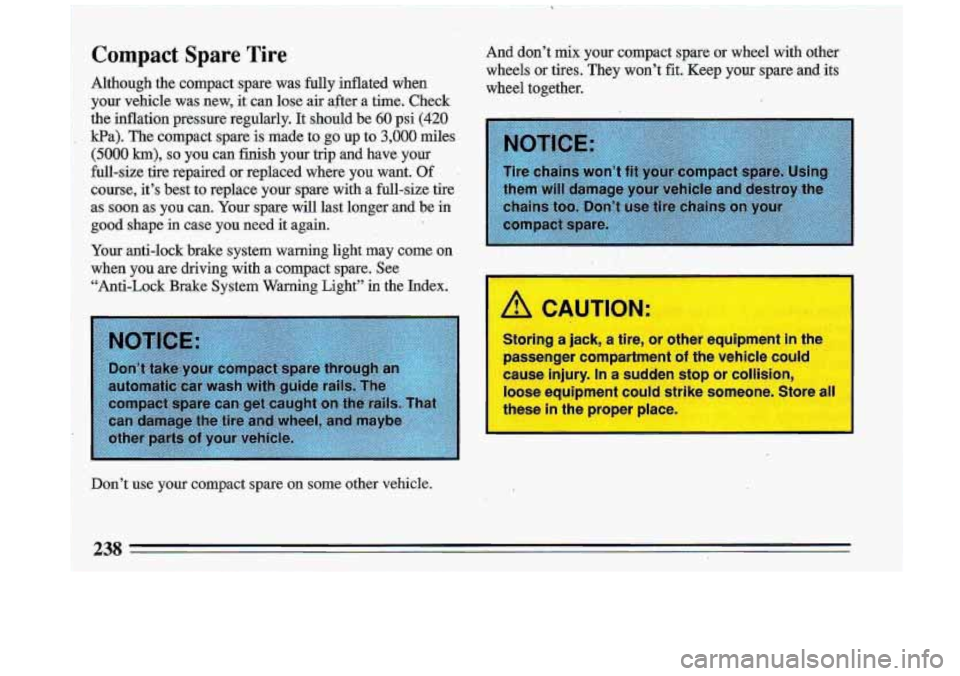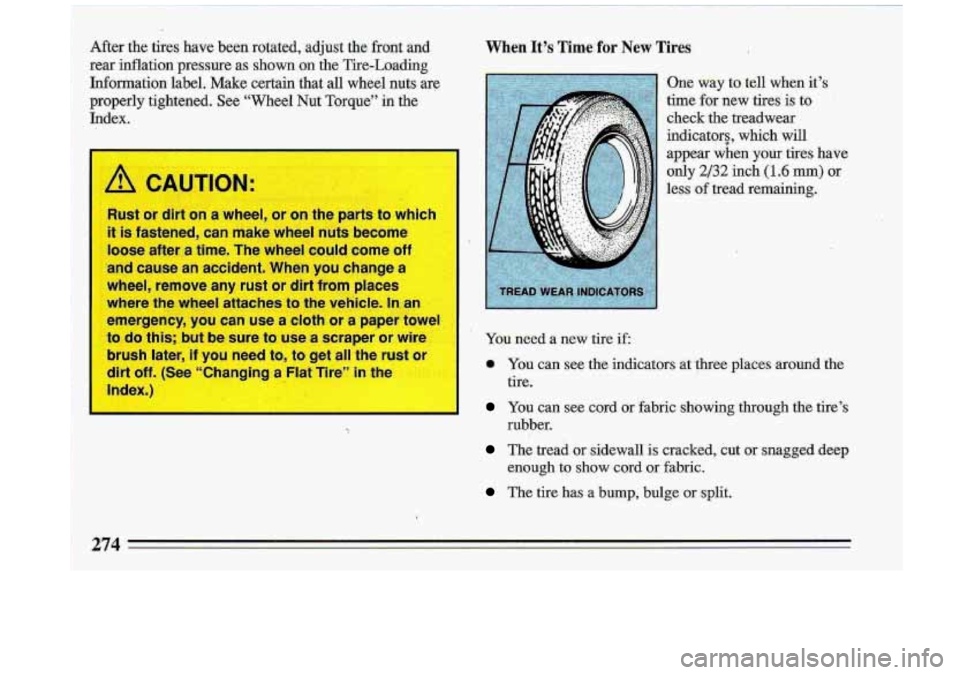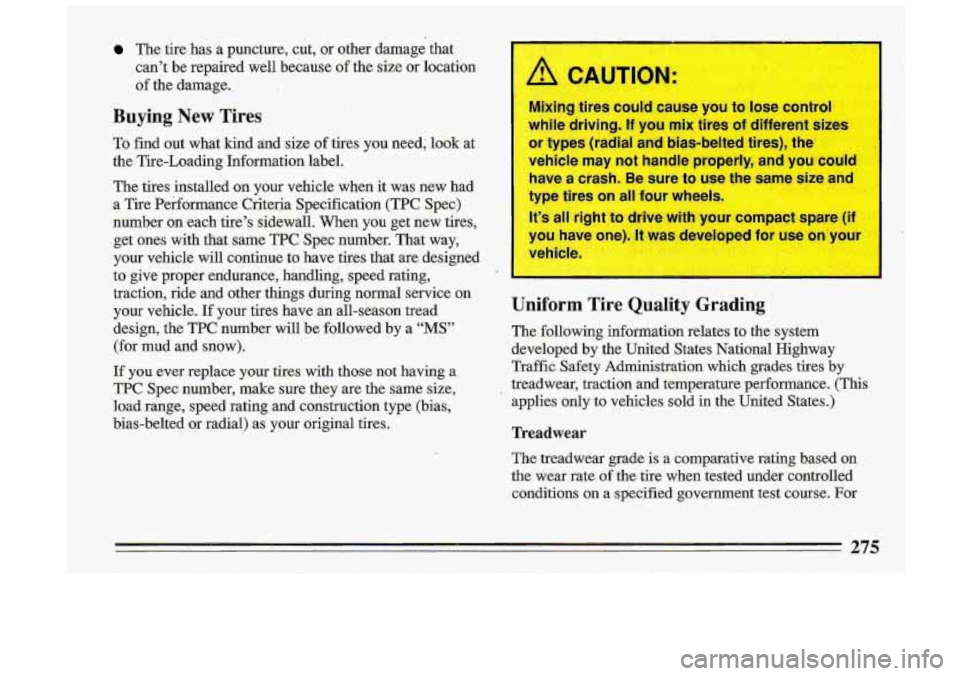Page 231 of 340
Remove, this wheel cover by carefully prying off the If your vehicle \
has wire wheel covers, .remove the center
center
-of the cover with the flat end of the wheel of the wheel cover by using the wire wheel key wrench.
wrench.
Page 234 of 340
I 'P J 'IC
Getting UI er a vehicle when i s j; ied up is
dangerous. If the vehicle slips off the jack, you
could be badly injured or kilied. Never get wnder
a hide wh I it. orted only by a jack.
Position theijack under the vekcle. ,Your .Buick,has:.m' '.
indentat&n,on the .fi-ame near each 'of the wheels. Raise ' '
the jack so the,jack head fits into-the indentation nearest
the wheel with the flat tire.
232
Page 236 of 340
CAUTIO A
Rust or dirt on the wheel,
which it
is fastened, can make the wheel nu
become loose after a time. The wheel could
come
off and cause an accident. When you
change
a wheel, remove any rust or dirt fro1
the places where the wheel attaches to the
vehicle. In an emergency, you can use
a cloth or
a paper towel to
do this; but be sure to use a
scraper or wire brush later, if you need to, to get
all the r---t or dirt off.
N use oil or gre
e on stu
Remove any rust or dirt fro-rn the wheel bolts, rnoullLl1lg
surfaces or spare wheel. Place the spare on the wheel
mounting surface.
Replace.
the wheel nuts with the rounded end of the nuts
toward the wheel. Tighten each nut by hand until the
wheel is held against the hub.
234
Page 237 of 340
t
Lower the vehicle by rotating the wheel wrench
counterclockwise. Lower the jack completely.
Tighten the wheel nuts
firmly in a criss-cross
sequence as shown.
lncorrect wheel nuts or improperly tightened
wheel nuts can cause the wheel to become
loose and even come
off. This could lead to an
accident. Be sure to use the correct wheel nuts.
If you have to replace them, be sure to get the
right kind.
Stop somewhere
as soon as you can an
have the nuts tightened with
a
to I00 ft. Ibs. (1 40 N.m)
Don't try to put a wheel cover on your compact spare
tire. It won't fit. Store the wheel cover until
you have
the flat tire repaired or replaced.
. .. .i ,?. 1 C.".
235
Page 240 of 340

Compact Spare T,ire
Although the compact spare was fully inflated when
your vehicle -was new, it can lose air after a time. Check
the inflation pressure regularly. It should be
60 psi (420
Pa). The compact spare is made to g6 up to 3,000 miles
(50,OO km), so you can finish your trip and have. your
full-size tire repaired
or replaced where you want. Of
course, it’s best to replace your spare with a full-size ti\
re
as soon as you can. Your spare will last longer and be in
good shape in case you need it again.
Your anti-1ock.brake system warning light -may come on
when you are driving with a compact spare. See
“Anti-Lock Brake System Waming Light”
in the Index.
Don’t-use
your compact spare on some other vehicle. And don’t mix your compact spare or wheel
with other
wheels or tires. They. won’t
fit.. Keep your spare and its
wheel together.
., ,. .. .. , ...
L CAUTIOF
s J a Jal , a we, or orner equlpmenr in rn
passenger compartment of the vehicle could
cause injury. In
a sudden stop or collision,
loose equipment could strike someone. Store al
these
in the proper place
3s
Page 241 of 340
I A CAUTION:
If you let your tires spin at high eed, the I
explode and YOU or others could be injured.
And, the transmission or other parts of the
vehicle can overheat. That could cause an
engine compartment fire other damage.
When
you’re stuck, spin the wheels as little as
possible. Don’t spin the wheels above 35 I h
(55 km/h) as shown on the speedome r. c
239
Page 276 of 340

After the tires have beers rotated, adjust the front and
rea inflation pressure as shown on the Tire-Loading
Information label. Make certain that all wheel nuts ax9
properly tightened. See “Wheel Nut Torque” in the
’ ..
Index.
A CAUTION:
Rust or diir on a wheel, or on the parts to which
it is fastened, can make wheel nuts become
loose after a time. The wheel-could come off
‘and cause an accident. When you change a
wheel, remove any rust or dirt from places
where the wheel attaches to the vehicle.
In an
emergency, you can use a’cloth or a paper towel
to
do this; but be sure to use a scraper or wire
brush later,
if you need to, to get all the rust --
dirt off. (See “Changing a Flat Tire” in the
Index.)
I
When It’s Time for New Tires
One way to tell when it’s
time for new tires
is to.
check the treadwear’-
*. ’
indicators, which will
appear when your tires have only
2/32 inch (1.6 mm) or
less of tread remaining.
I
I
.’
DU need a new tire if
You can see the indicators at three places around the
tire.
You can see cord or fabric showing through the tire’s
The tread or sidewall is cracked, cut -or snagged deep
rubber.
enough to show cord or fabric.
The tire has a bump, bulge or .split.
274
Page 277 of 340

The tire has a puncture, cut, or other damage that
can’t be repaired well because of the size or location
of the damage.
Buying New Tires
.To find out what kind and size of tires you need; look at
the Tire-Loading Information label.
The tires installed on your vehicle when it was new had
a Tire Performance Criteria Specification
(TPC Spec)
-number on each tire’s sidewall. When you get new tires, get ones with that same TPC Spec number.
That way,
your vehicle will continue
to have tires that are designed
to give proper endurance, handling, speed rating,
traction, ride and other things during normal service on
your vehicle.
If your tires have an all-season tread
design, the
TPC nu-mber will be followed. by a “MS”
(for mad and snow).
If you ever replace your tires with those not having a
TPC Spec number, make sure .they are the same size,
load range, speed rating and construction type (bias,
bias-belted or radial) as your original tires.
‘t
A CAUTION:
Mixing tires could cause you to lose control
while driving. If you mix tires of different siz
or types (radial and bias-belted tires), the
vehicle may not handle properly, and you
cows
have a crash. Be sure to use the same size and
type tires
on all four wheels.
It’s all right to drive with your compact spare (if
you have one). It
was developed for use on your
I
I
‘ :le.
Uniform Tire Quality Grading
The following information relates to the system
developed by the United States National Highway
Traffic Safety Administration which grades tires
by
treadwear, traction and temperature performance. (This
applies only to vehicles sold
in the United States.)
Treadwear
The treadwear grade is a comparative rating based on
the wear rate of the tire when tested under controlled
conditions
on a specified govement test course. For
I